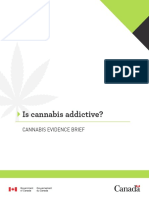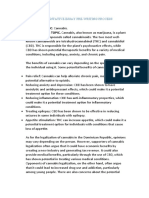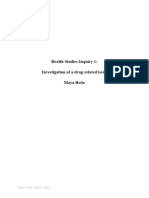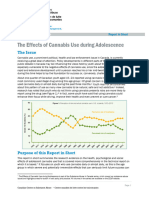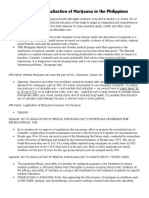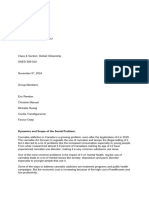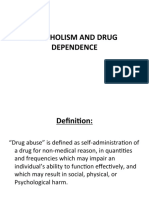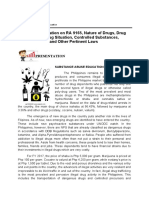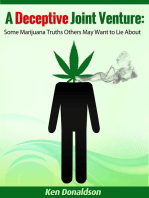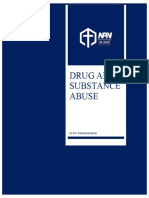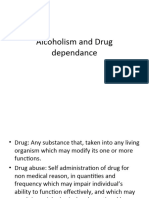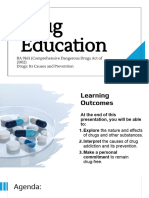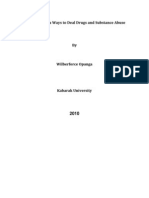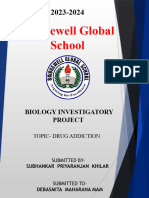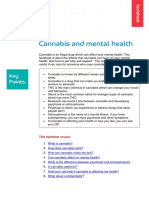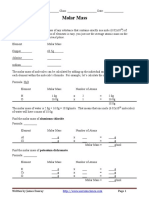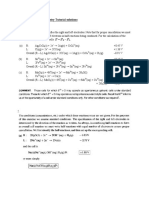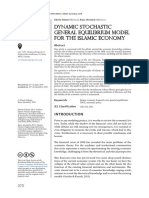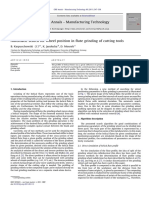0 ratings0% found this document useful (0 votes)
23 viewsCanabis
Canabis
Uploaded by
ClaytonMitchellJr.Cannabis can affect the body both positively and negatively. It can provide pain relief but also increase lung irritation and impair judgment. Addiction to cannabis can financially burden individuals and families. It can negatively impact relationships as addicts neglect family duties to spend time with other drug users. Financial strain is associated with more severe cannabis use problems and greater barriers to quitting.
Copyright:
© All Rights Reserved
Available Formats
Download as PPTX, PDF, TXT or read online from Scribd
Canabis
Canabis
Uploaded by
ClaytonMitchellJr.0 ratings0% found this document useful (0 votes)
23 views11 pagesCannabis can affect the body both positively and negatively. It can provide pain relief but also increase lung irritation and impair judgment. Addiction to cannabis can financially burden individuals and families. It can negatively impact relationships as addicts neglect family duties to spend time with other drug users. Financial strain is associated with more severe cannabis use problems and greater barriers to quitting.
Copyright
© © All Rights Reserved
Available Formats
PPTX, PDF, TXT or read online from Scribd
Share this document
Did you find this document useful?
Is this content inappropriate?
Cannabis can affect the body both positively and negatively. It can provide pain relief but also increase lung irritation and impair judgment. Addiction to cannabis can financially burden individuals and families. It can negatively impact relationships as addicts neglect family duties to spend time with other drug users. Financial strain is associated with more severe cannabis use problems and greater barriers to quitting.
Copyright:
© All Rights Reserved
Available Formats
Download as PPTX, PDF, TXT or read online from Scribd
Download as pptx, pdf, or txt
0 ratings0% found this document useful (0 votes)
23 views11 pagesCanabis
Canabis
Uploaded by
ClaytonMitchellJr.Cannabis can affect the body both positively and negatively. It can provide pain relief but also increase lung irritation and impair judgment. Addiction to cannabis can financially burden individuals and families. It can negatively impact relationships as addicts neglect family duties to spend time with other drug users. Financial strain is associated with more severe cannabis use problems and greater barriers to quitting.
Copyright:
© All Rights Reserved
Available Formats
Download as PPTX, PDF, TXT or read online from Scribd
Download as pptx, pdf, or txt
You are on page 1of 11
CANNABIS
Group Names: Shanneil Brown,
Ricardo Grubb, Dejahnae Kellier
Grade: 11L
Teacher: Mr. Mitchell
Table of
Contents
Introduction.....3
Cannabis & Its affect On The Body.....4-
5
How does cannabis affect the user.....6
How does cannabis affect the
family.....7
How does cannabis affect relationships
and wider society.....8
Financial effects on the individual and
the country on the misuse of
cannabis.....9-10
Reference.......................................... 11
• In this presentation we will be sharing
some information on 'Cannabis'.
• Cannabis, also known as marijuana
among other names, is a psychoactive
drug from the cannabis plant. Native to
Introduction Central or South Asia, the cannabis
plant has been used as a drug for both
recreational and entheogenic purposes
and in various traditional medicines for
centuries.
• Now let us get into the rest of our
presentation
Cannabis can be classified as a depressant,
stimulant, or hallucinogen. It can affect the
body in many ways. It can also provide pain
relief and a feeling of calm, but also increase
lung irritation, impair memory and judgment,
and cause eye redness.
Many effects of cannabis are short-term,
CANNABIS & meaning that they last for only a short period.
Other effects are long-term and may not show
ITS AFFECT up immediately. Smoking cannabis has both
negative and positive effects.
ON THE Positive effects:
• reducing pain associated with certain medical
BODY conditions
• reducing inflammation
• helping with glaucoma
• reducing nausea in people undergoing
chemotherapy
Negative effects:
• a higher likelihood of developing bronchitis, when a person smokes it
• more phlegm, when a person smokes it
• lung irritation from irritants including some carcinogens, such as accidentally burning the
mouth or throat when smoking
• a weakened immune system due to the effects of tetrahydrocannabinol, which is the
main psychoactive chemical in cannabis
• pain relief
• reduction in vomiting and nausea
• faster heart rate by 20-50 beats per minute
• red eyes from the increase in blood flow
• relief from the symptoms of glaucoma, for short periods
• aggravation of existing lung conditions, such as asthma, when a person smokes it
• potential interference with tumor growth
• interference with fetal development during pregnancy
• interference with brain development among teenagers
• Addiction causes heartache and
hardship for family members, and its
effects can sometimes be passed
down through generations. Spouses
and children of addicts are more often
the victims of domestic abuse.
HOW DOES Financial hardships can also impact
CANNABIS the family, caused by the addict's
need to buy drugs, as well as from his
AFFECT FAMILY inability to find consistent
employment. The family of an addict
often exists under a veil of denial.
They struggle to present a positive
public image, while secretly living in
shame and fear.
Many people experience a pleasant
euphoria and sense of relaxation. Other
common effects, which may vary
dramatically among different people,
include heightened sensory perception (
e.g., brighter colors ),laughter, altered
HOW DOES perception of time, and increased
CANNABIS AFFECT appetite. They also have a much higher
THE USER chance of developing dependence,
using other drugs, and attempting
suicide. Several studies have also
linked heavy marijuana use to lower
income, greater welfare dependence,
unemployment, criminal behavior, and
lower life satisfaction.
• Addiction often causes the addict’s
disapproving friends to distance
HOW DOES themselves. Alternately, the addict may
abandon non-addicted friends in favor
CANNABIS of those who share and endorse their
addictive habits.
AFFECT • In the company of other addicts, drug
RELATIONSHIP use begins to seem normal. Addicts
S AND WIDER will often neglect their family duties to
share the company of those who won’t
SOCIETY interfere with their drug use. The
stability of these addictive friendships
is tenuous.
• Cannabis is by far the most widely cultivated, trafficked
and abused illicit drug. Half of all drug seizures
worldwide are cannabis seizures. The geographical
spread of those seizures is also global, covering
practically every country of the world. About 147 million
FINANCIAL people, 2.5% of the world population, consume
cannabis (annual prevalence) compared with 0.2%
EFFECTS ON consuming cocaine and 0.2% consuming opiates. In the
present decade, cannabis abuse has grown more rapidly
THE than cocaine and opiate abuse.
• The most rapid growth in cannabis abuse since the
INDIVIDUAL 1960s has been in developed countries in North
AND THE America, Western Europe and Australia. Cannabis has
become more closely linked to youth culture and the
COUNTRY ON age of initiation is usually lower than for other drugs. An
analysis of cannabis markets shows that low prices
THE MISUSE OF coincide with high levels of abuse, and vice versa.
Cannabis appears to be price-inelastic in the short term,
CANNABIS but elastic over the longer term. Though the number of
cannabis consumers is greater than opiate and cocaine
consumers, the lower prices of cannabis mean that, in
economic terms, the cannabis market is much smaller
than the opiate or cocaine market.
• Social determinants of health may be potentially relevant to
better understand cannabis use problems among adults. As
such, the current study sought to provide an initial test of the
role of financial strain, a prominent social determinant of
health, in cannabis use problems and perceived barriers for
cannabis cessation among African American/Black adults.
Participants were 76 (32.9% female, Mage = 38.64, SD =
10.82) adult, current cannabis users. Hierarchical regression
results indicated that greater financial strain was associated
with more cannabis use problems and greater perceived
barriers for cannabis cessation; such effects were evident
above and beyond the variance explained by a range of
relevant covariates, including age, sex, income, education,
and depressive symptoms. These findings suggest addressing
financial strain (e.g., financial planning, psychoeducation
about the handling financial stress) may be a useful
therapeutic tactic in the larger landscape of treatment
programming when targeting cannabis use behaviors and
beliefs among adult cannabis users.
• The Effects of Drug Addiction on
Relationships | Healthfully
,
SAMHSA - Substance Abuse and
Mental Health Services Administr
References ation
,
NIDA.NIH.GOV | National Institut
e on Drug Abuse (NIDA)
,
World Health Organization (WHO
),
Taylor & Francis Online: Peer-revi
You might also like
- Microeconomics: by Robert S. Pindyck Daniel Rubinfeld Ninth EditionDocument44 pagesMicroeconomics: by Robert S. Pindyck Daniel Rubinfeld Ninth EditionClaytonMitchellJr.No ratings yet
- Formation of Ions Lesson PlanDocument3 pagesFormation of Ions Lesson PlanClaytonMitchellJr.No ratings yet
- Microeconomics: by Robert S. Pindyck Daniel Rubinfeld Ninth EditionDocument51 pagesMicroeconomics: by Robert S. Pindyck Daniel Rubinfeld Ninth EditionClaytonMitchellJr.No ratings yet
- Fundamentals and Special Crime InvestigationDocument62 pagesFundamentals and Special Crime InvestigationKevin Rollen100% (3)
- Motivation Letter Sample For A PHD in BiotechnologyDocument8 pagesMotivation Letter Sample For A PHD in BiotechnologyDesyHyukkie Anchovy50% (4)
- Biology Project: Drug AbuseDocument15 pagesBiology Project: Drug AbuseSezzal KujurNo ratings yet
- Cannabis Related Disorders EditedDocument46 pagesCannabis Related Disorders EditedPriyanka KoundinyaNo ratings yet
- Cannabis Effect On Mental HealthDocument5 pagesCannabis Effect On Mental Healthammaramaryam6463No ratings yet
- Get The Facts About DrugsDocument12 pagesGet The Facts About Drugsgutisauriorex74No ratings yet
- Cannabis AddictionDocument6 pagesCannabis AddictionGiancarlo BarbiniNo ratings yet
- Cannabis Use Disorder DoneDocument8 pagesCannabis Use Disorder Doneapi-333107914No ratings yet
- World Health Organization - Cannabis UseDocument11 pagesWorld Health Organization - Cannabis UseEtienne BellemareNo ratings yet
- Cannabis: PharmacologyDocument6 pagesCannabis: PharmacologyAntonio Tejero PocielloNo ratings yet
- Drug and Substance Abuse Prevention and ControlDocument28 pagesDrug and Substance Abuse Prevention and ControlKarlyn Ramos100% (1)
- Za Cda Cannabis Position 2009 PDFDocument73 pagesZa Cda Cannabis Position 2009 PDFbillymamboNo ratings yet
- Pre-Writing Process 4 6 TTHDocument5 pagesPre-Writing Process 4 6 TTHyuypNo ratings yet
- Substance Related DisorderDocument15 pagesSubstance Related DisorderSurbhi RomeshNo ratings yet
- Health Inquiry Task FinalDocument43 pagesHealth Inquiry Task Finaltinyteddy452No ratings yet
- Chapter Highlights From NAS Report The Health Effects of Cannabis and Cannabinoids ConclusionsDocument2 pagesChapter Highlights From NAS Report The Health Effects of Cannabis and Cannabinoids ConclusionsPBS NewsHour100% (1)
- CCSA Effects of Cannabis Use During Adolescence Summary 2015 enDocument9 pagesCCSA Effects of Cannabis Use During Adolescence Summary 2015 enDaniel DdiazNo ratings yet
- Efectos Del Canabis.Document9 pagesEfectos Del Canabis.InfernoNo ratings yet
- Development and Course: TemperamentalDocument4 pagesDevelopment and Course: TemperamentalAuliya SyismaNo ratings yet
- OPPOSITE: Legalization of Marijuana in The PhilippinesDocument2 pagesOPPOSITE: Legalization of Marijuana in The PhilippinesNathalie GetinoNo ratings yet
- NSTP100 Substance Abuse EducationDocument43 pagesNSTP100 Substance Abuse EducationOtto OctaviusNo ratings yet
- Alcohol AbuseDocument16 pagesAlcohol Abusesibandamncedisi95No ratings yet
- BIOLOGY ProjectDocument12 pagesBIOLOGY Projecttheodore deepakNo ratings yet
- Cannabis Risks The Public Should Know190805Document19 pagesCannabis Risks The Public Should Know190805EchoNewsNo ratings yet
- Untitled document (3)Document4 pagesUntitled document (3)favouroseji6No ratings yet
- CANNABIS USE AND MISUSEDocument25 pagesCANNABIS USE AND MISUSEKemisola.m BNo ratings yet
- Alcoholism and Drug DependenceDocument52 pagesAlcoholism and Drug DependenceSivaNo ratings yet
- anum all casesDocument81 pagesanum all casesforsure963No ratings yet
- Mapeh 9 - NotesDocument5 pagesMapeh 9 - NotesBeyoung GamefightNo ratings yet
- biology projectDocument25 pagesbiology projectpainterramdev40No ratings yet
- Mercy Drugs AbuseDocument10 pagesMercy Drugs Abuseyaji ezraNo ratings yet
- Substance Use AndabuseDocument40 pagesSubstance Use AndabuseZoe GudenNo ratings yet
- Drug Addiction. BioDocument19 pagesDrug Addiction. BioLIGHT YAGAMINo ratings yet
- Drug EducationDocument15 pagesDrug EducationShifra Jane PiqueroNo ratings yet
- A Deceptive Joint Venture: Some Marijuana Truths Others May Want to Lie AboutFrom EverandA Deceptive Joint Venture: Some Marijuana Truths Others May Want to Lie AboutRating: 4 out of 5 stars4/5 (1)
- Drugs and Substance AbuseDocument15 pagesDrugs and Substance AbuseEve Lexy MutituNo ratings yet
- projjDocument28 pagesprojjarchanastudiosNo ratings yet
- Drug AbuseDocument11 pagesDrug AbuseZainab MohammedNo ratings yet
- Is Marijuana AddictiveDocument8 pagesIs Marijuana AddictivebrindusaNo ratings yet
- Cannabis y Diagnósticos DualesDocument15 pagesCannabis y Diagnósticos DualesMariaNo ratings yet
- Alcoholism and Drug DependanceDocument53 pagesAlcoholism and Drug DependanceDr.Shreedhar RawalNo ratings yet
- ESTHER ONISOYA SAM PROJECT WORK 1Document13 pagesESTHER ONISOYA SAM PROJECT WORK 1godswordjacob93No ratings yet
- Mariguana InformationDocument8 pagesMariguana InformationAlberto Aguirre SanchesNo ratings yet
- Drugs AbuseDocument20 pagesDrugs AbuseKrishnaNo ratings yet
- Lesson 4 Drug Education.pptxDocument16 pagesLesson 4 Drug Education.pptxjeremyaguileraaaNo ratings yet
- Cds Outreach On DrugsDocument6 pagesCds Outreach On DrugseverlastingschoolabakalikiNo ratings yet
- Project Report On Drug AddictionDocument12 pagesProject Report On Drug Addictionpadmaja ppNo ratings yet
- Module 8 Notes Drugs and AlcoholDocument10 pagesModule 8 Notes Drugs and AlcoholJeana JohnsonNo ratings yet
- Proposal On Ways of Curbing The Challenge of Drug AbuseDocument12 pagesProposal On Ways of Curbing The Challenge of Drug AbuseWilberforce Opanga79% (14)
- Group 3Document17 pagesGroup 3Jay JayNo ratings yet
- Subhankar BiologyDocument21 pagesSubhankar BiologyvvdgkyezyiNo ratings yet
- Cannabis and Mental Health Factsheet PDFDocument12 pagesCannabis and Mental Health Factsheet PDFCristiNo ratings yet
- TP Weed 3Document53 pagesTP Weed 3MohamedNo ratings yet
- Drugs and Alcohol Abuse 1Document23 pagesDrugs and Alcohol Abuse 1SAMIKSHANo ratings yet
- Child Adolesc Psychiatr Clin N Am 2020 29 1 145-56Document12 pagesChild Adolesc Psychiatr Clin N Am 2020 29 1 145-56Fernando SousaNo ratings yet
- Chapter 1: Introduction of The Study: Drug Abuse in NigeriaDocument40 pagesChapter 1: Introduction of The Study: Drug Abuse in NigeriaAKINYEMI ADISA KAMORUNo ratings yet
- 289-332 Salud MentalDocument45 pages289-332 Salud MentalPablo MoralesNo ratings yet
- Substance AbuseDocument21 pagesSubstance Abuserishabhgndu2023No ratings yet
- Cannabis Use and Cannabis Use DisorderDocument24 pagesCannabis Use and Cannabis Use Disordercursogratuitos1309No ratings yet
- Drug Addiction: by SanketDocument12 pagesDrug Addiction: by SanketSanket JhunjhunwalaNo ratings yet
- Substance Use in The PhilippinesDocument54 pagesSubstance Use in The PhilippinesAngelah ManikisNo ratings yet
- EcstasyDocument7 pagesEcstasyClaytonMitchellJr.No ratings yet
- CocaineDocument6 pagesCocaineClaytonMitchellJr.No ratings yet
- GR 11 Drug Abuse Project 2023Document1 pageGR 11 Drug Abuse Project 2023ClaytonMitchellJr.No ratings yet
- Faculty of Science and Technology Guild Committee, UWI Mona & Lucozade Partnership 2016-2017Document6 pagesFaculty of Science and Technology Guild Committee, UWI Mona & Lucozade Partnership 2016-2017ClaytonMitchellJr.No ratings yet
- Boost TasksDocument1 pageBoost TasksClaytonMitchellJr.No ratings yet
- Faculty of Science and Technology Guild Committee, UWI Mona & Red Bull Partnership 2016-2017Document5 pagesFaculty of Science and Technology Guild Committee, UWI Mona & Red Bull Partnership 2016-2017ClaytonMitchellJr.No ratings yet
- Letter To Juici PattiesDocument5 pagesLetter To Juici PattiesClaytonMitchellJr.No ratings yet
- Faculty of Science and Technology Guild Committee, UWI Mona & Juici Patties Partnership 2016-2017Document5 pagesFaculty of Science and Technology Guild Committee, UWI Mona & Juici Patties Partnership 2016-2017ClaytonMitchellJr.No ratings yet
- Agenda For FSTGC Meeting Date: Wednesday, 11th January, 2016 at 1:00p.m Venue: SLT 3Document1 pageAgenda For FSTGC Meeting Date: Wednesday, 11th January, 2016 at 1:00p.m Venue: SLT 3ClaytonMitchellJr.No ratings yet
- Mr. Damion Crawford, Lecturer, Marketing, UWI, Mona Campus. Dear Mr. D. CrawfordDocument4 pagesMr. Damion Crawford, Lecturer, Marketing, UWI, Mona Campus. Dear Mr. D. CrawfordClaytonMitchellJr.No ratings yet
- Molar Mass: Molar Mass Is The Amount of Mass of Any Substance That Contains Exactly One Mole (6.02x10Document2 pagesMolar Mass: Molar Mass Is The Amount of Mass of Any Substance That Contains Exactly One Mole (6.02x10ClaytonMitchellJr.No ratings yet
- Relative Atomic Masses Mass SpectrometryDocument43 pagesRelative Atomic Masses Mass SpectrometryClaytonMitchellJr.No ratings yet
- Microeconomics: by Robert S. Pindyck Daniel Rubinfeld Ninth EditionDocument35 pagesMicroeconomics: by Robert S. Pindyck Daniel Rubinfeld Ninth EditionClaytonMitchellJr.No ratings yet
- October Vacation Rental Blog CalendarDocument1 pageOctober Vacation Rental Blog CalendarClaytonMitchellJr.No ratings yet
- 05 - Percent CompositionDocument2 pages05 - Percent CompositionClaytonMitchellJr.No ratings yet
- CHEM2310 Electrochemistry Tutorial Solutions - Typed - Nov 2013Document4 pagesCHEM2310 Electrochemistry Tutorial Solutions - Typed - Nov 2013ClaytonMitchellJr.No ratings yet
- Measuring With MolesDocument12 pagesMeasuring With MolesClaytonMitchellJr.100% (1)
- Gazebo QuotationDocument4 pagesGazebo QuotationClaytonMitchellJr.No ratings yet
- CHEM2310 December 2017Document4 pagesCHEM2310 December 2017ClaytonMitchellJr.No ratings yet
- FSTGC - ReportDocument2 pagesFSTGC - ReportClaytonMitchellJr.No ratings yet
- CHEM2310 Exam Dec 2015Document5 pagesCHEM2310 Exam Dec 2015ClaytonMitchellJr.No ratings yet
- Me 463-Machine Design 2: Instructor: Engr. Danielle D. Cabana, MengDocument32 pagesMe 463-Machine Design 2: Instructor: Engr. Danielle D. Cabana, MengChristian Breth Burgos50% (2)
- The Ballad of East and West - KiplingDocument3 pagesThe Ballad of East and West - Kiplingnicoler111No ratings yet
- Registration Form: Seminar Name: Seminar Location: Seminar Name: Seminar LocationDocument2 pagesRegistration Form: Seminar Name: Seminar Location: Seminar Name: Seminar LocationObi A AgusioboNo ratings yet
- Wireless Distribution SystemDocument14 pagesWireless Distribution SystemSajith Lakshitha EdirisingheNo ratings yet
- Steroid Tapering and Supportive Treatment Guidance V1.0 PDFDocument1 pageSteroid Tapering and Supportive Treatment Guidance V1.0 PDFdokteruciNo ratings yet
- Module 2 PPT GE11Document32 pagesModule 2 PPT GE11Wayne Andrea TualaNo ratings yet
- Refresher ProbSet4Document15 pagesRefresher ProbSet4Ellen Mae PrincipeNo ratings yet
- Distributed Forces: Centroids and Centers of GravityDocument54 pagesDistributed Forces: Centroids and Centers of Gravityjunnoet21No ratings yet
- Cid 2 CodeDocument322 pagesCid 2 CodeTạ ĐạtNo ratings yet
- KA3S1265R/KA3S1265RF/ KA3S1265RD: Fairchild Power Switch (FPS)Document12 pagesKA3S1265R/KA3S1265RF/ KA3S1265RD: Fairchild Power Switch (FPS)Rigoberto RujanoNo ratings yet
- Operation of Oil Tankers and General Precautions OnboardDocument5 pagesOperation of Oil Tankers and General Precautions OnboardWilson PinacateNo ratings yet
- IM MPC431 E - 2ndDocument80 pagesIM MPC431 E - 2ndAnatoliyNo ratings yet
- Instant Download Power Electronics Handbook 3rd Edition Rashid Muhammad PDF All ChaptersDocument62 pagesInstant Download Power Electronics Handbook 3rd Edition Rashid Muhammad PDF All Chaptersjuncaimonila100% (6)
- C&B 12 RBBDocument89 pagesC&B 12 RBBNam BuiNo ratings yet
- I Am Sharing 'Jsjabahvdnfb' With YouDocument2 pagesI Am Sharing 'Jsjabahvdnfb' With Youlady magpantayNo ratings yet
- Feasibility Study 2013Document6 pagesFeasibility Study 2013John Morrel D. MirandaNo ratings yet
- (LINA) Assignment Data AnalysisDocument8 pages(LINA) Assignment Data AnalysislynaAPPLESNo ratings yet
- Impromptu Speech AssignmentDocument3 pagesImpromptu Speech AssignmentAprildiema SarimNo ratings yet
- Module 2 SampleDocument15 pagesModule 2 SampleSilver HeartNo ratings yet
- d20 4e One Bad Egg Poisoncraft The Codex VenenorumDocument51 pagesd20 4e One Bad Egg Poisoncraft The Codex VenenorumDominic TurcotteNo ratings yet
- General Biology 2 (Midterm) LEARNING ACTIVITY #5 Identifying Amphibians Using Dichotomous KeyDocument5 pagesGeneral Biology 2 (Midterm) LEARNING ACTIVITY #5 Identifying Amphibians Using Dichotomous KeyshusuishigakiNo ratings yet
- Imfi 2018 03 Dahani PDFDocument13 pagesImfi 2018 03 Dahani PDFAmine IzamNo ratings yet
- Automatic Search For Wheel Position in Flute Grinding of Cutting ToolsDocument4 pagesAutomatic Search For Wheel Position in Flute Grinding of Cutting ToolsGustavo FerronattoNo ratings yet
- Principle of Weak InFeed Echo Permissive Over Reach Transfer Trip SchemesDocument6 pagesPrinciple of Weak InFeed Echo Permissive Over Reach Transfer Trip SchemesThirumalNo ratings yet
- Jerika Updated ResumeDocument1 pageJerika Updated Resumeapi-238292382No ratings yet
- Fed 53Document57 pagesFed 53manuel.capulin.28No ratings yet
- Periodical Exam in TVL 11 at 1234Document8 pagesPeriodical Exam in TVL 11 at 1234sallyNo ratings yet
- Dialectical Behavior TherapyDocument18 pagesDialectical Behavior TherapyMishal FatimaNo ratings yet









